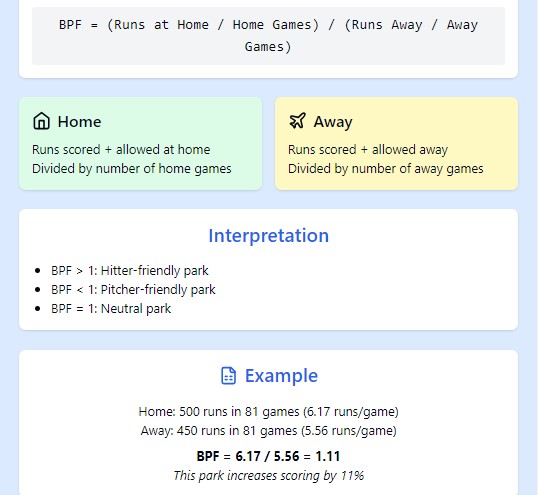This batting park factor BPF calculator is a handy tool in baseball analytics, designed to help evaluate how a particular ballpark influences runs scored, providing insights into whether a venue is hitter-friendly or pitcher-friendly.
Batting Park Factor (BPF) Calculator
| Park | Raw OPS | Park Factor | Adjusted OPS |
|---|---|---|---|
| A | .800 | 1.100 | 72.7 |
| B | .750 | 0.950 | 78.9 |
| C | .900 | 1.000 | 90.0 |
| D | .850 | 0.900 | 94.4 |
BPF Formula

The Basic Park Factor (BPF) formula is:
BPF = ((Runs Scored at Home + Runs Allowed at Home) / Home Games) / ((Runs Scored Away + Runs Allowed Away) / Away Games)A BPF of 1.000 indicates a neutral park. Values above 1.000 suggest a hitter-friendly environment, while those below favor pitchers.
I a team scores and allows 500 runs in 81 home games (12.35 runs per game) and 450 runs in 81 away games (11.11 runs per game), the BPF would be:
BPF = (12.35 / 11.11) = 1.112This result implies the home park increases run production by about 11.2% compared to a neutral environment.
How to calculate the park factor?
Calculating park factor involves several steps:
- Gather data: Collect run-scoring statistics for both home and away games.
- Calculate run rates: Determine runs per game for home and away scenarios.
- Apply the formula: Use the BPF equation mentioned earlier.
- Normalize: Adjust the result to account for sample size variations.
Team A’s season stats:
- Home: 400 runs scored, 350 runs allowed in 81 games
- Away: 350 runs scored, 375 runs allowed in 81 games
Home run rate = (400 + 350) / 81 = 9.26 runs/game
Away run rate = (350 + 375) / 81 = 8.95 runs/game
BPF = 9.26 / 8.95 = 1.035This park factor of 1.035 suggests Team A’s home field slightly favors hitters, increasing run production by about 3.5%.
What is the park factor rating?
The park factor rating is a standardized scale used to interpret BPF values. It typically ranges from 0.800 to 1.200, with 1.000 representing a neutral park.
- Ratings above 1.000: Indicate hitter-friendly parks
- Ratings below 1.000: Suggest pitcher-friendly venues
For example:
- A park with a 1.100 rating boosts offensive production by 10%
- A park rated at 0.900 suppresses scoring by 10%
What is the park factor in runs?
The park factor in runs translates the BPF into a tangible impact on run production. It quantifies how many additional runs (or fewer runs) a park contributes compared to a neutral environment.
To calculate this:
Subtract 1 from the BPF
Multiply by the league average runs per game
If the league average is 4.5 runs per game and a park has a BPF of 1.080:
Run impact = (1.080 - 1) * 4.5 = 0.36 runs per gameThis means the park contributes an extra 0.36 runs per game compared to a neutral venue.
What is league OPS adjusted for park factors?
League OPS (On-base Plus Slugging) adjusted for park factors is a metric that normalizes offensive production across different ballparks. It accounts for the varying impacts of different stadiums on hitting statistics.
To calculate this:
- Determine the player’s raw OPS
- Divide by the park factor
- Multiply by 100 to create an index (100 is average)
Player X has an OPS of .850 in a park with a factor of 1.050
Adjusted OPS = (.850 / 1.050) * 100 = 81This adjusted OPS of 81 suggests Player X’s performance is actually below average when accounting for their hitter-friendly home park.
Sources / References
Related Tools:
- Sauna Calories Burned Calculator – How Many Calories Can You Burn In A Sauna
- Jumping Jacks Calories Burned Calculator – How Many Calories Do Jumping Jacks Burn
- Calories Burned Snow Shoveling Calculator – How Many Calories Do I Burn Shoveling Snow
- Burpee Calorie Burn Calculator – How Many Burpees To Burn Calories
- Calories Burned by Heart Rate Calculator – Calculate Calories Burned Using Heart Rate
- Magic Number Calculator – Calculate Baseball Magic Number
- Calories Burned Playing Cricket Calculator
- Assist to Turnover Ratio Calculator – Find Your Assist/Turnover Ratio
- Batting Average Calculator (ODI, T20, Test)
- Effective Field Goal Percentage Calculator
- Slugging Percentage Calculator – Calculate Slugging Percentage in Baseball
- Batting Strike Rate Calculator T20, ODI, Test